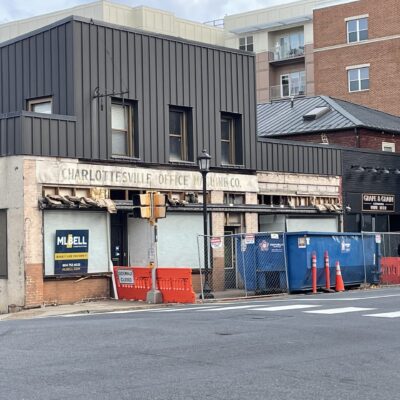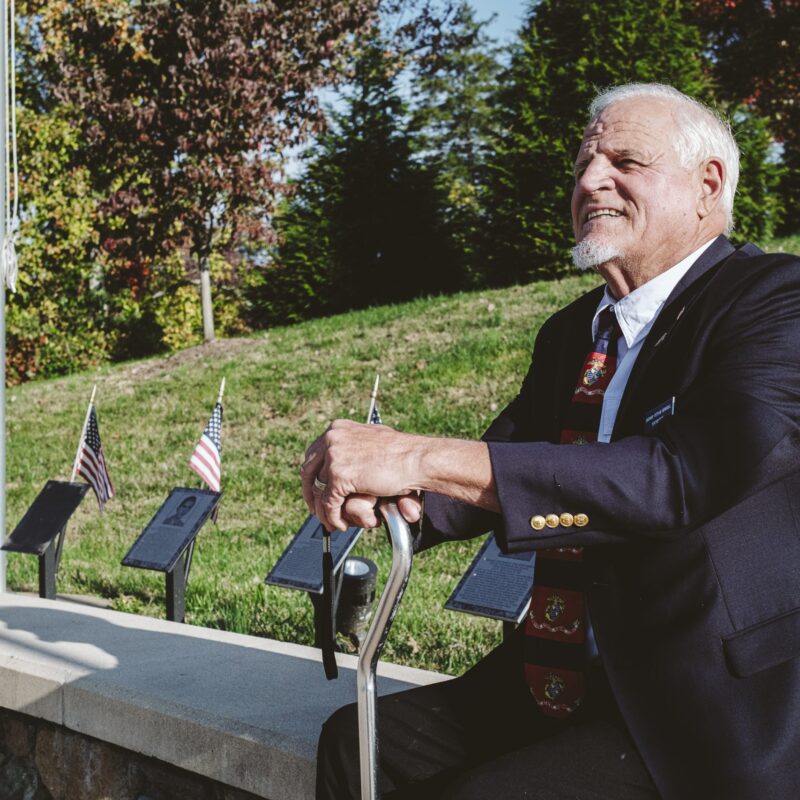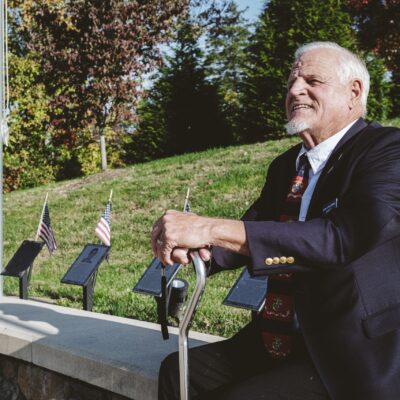Three lifeless pigs hang from six hooks in the walk-in fridge. Split in two, their bright skin is waxy white, traced with miniscule purple veins. A small, pink pearl sliding down one ankle is the only visible sign of blood. Each carcass shows outward evidence of the animal it once was: little pink toenails, traces of black hair, tails, nipples. But, inside, they are now hollowed out—vital organs like hearts and lungs missing, muscles and bones forming a red and white topographical map of meat. The room is cold; the smell is wonderfully deep and spicy.
|
Richard Bean learned to cut meat as he grew up helping his father in a Massachusetts butcher shop. |
“First thing you’ll get,” Richard Bean says, “is the straight carcasses.” Carcasses that begin as living Berkshire hogs, some weighing 400 pounds or more, with black bodies that are mud-streaked and scarred from fighting. They swim in dirt pools and wander through forests of paradise trees on Bean’s 32-acre farm, near Wingina, 40 miles south of Charlottesville. At T&E Meats in Harrisonburg, when they’re six months old and 250 pounds, they’re killed (that’s a court-ordered necessity owing to Bean’s arrest, two years ago, for illegally killing pigs himself. See sidebar, p. 17). Bean’s partner, Jean Rinaldi, picks them up three days later and brings them back to the farm to be butchered. They arrive 75 pounds lighter and cut in half, with the head removed but the skin left on. “Pigs are hard to skin,” Bean says, so instead the carcasses are scalded at the slaughterhouse with a machine that removes the hair but leaves the skin, which Bean will take off himself and which, when fried, makes a delicious and nutritious snack.
Every part of the pig is usable.
That includes the head, which Bean pulls out of a container wrapped in plastic and slaps down on a table so that it stares straight ahead, milky gray eyes bulging, tongue extended out of a partially skinned snout. There is a penny-sized hole in the forehead where, after the pig is dead, its brains are literally blown out. In less squeamish societies, they make viable food, too.
“There is a tremendous amount of nutrition,” Bean says, “in what some people would call the waste.”
To take “butcher” to mean “botch or mangle” is to mangle the true meaning of the word. A good butcher does anything but that. Sixty-five-year-old Richard Bean, co-owner of Double H Farm in Nelson County, purveyor of sustainably raised pork, poultry and vegetables, is one of the last real butchers around. This is due to regulations on handling meat and also because, as Bean sees it, butchering belongs to a bygone era in this country, an era when people were closer to the source of their food. Closer to the viscera.
|
Bean butchers three pigs per week, but soon he may have to increase to four. |
Bean holds a skinny knife in his right hand and a hook in the other and he stabs the hook into the carcass a third of the way up from where the head would have been. Secured, he begins to draw the knife below the hook through the skin and flesh, from right to left across the empty expanse of the ribs. The knife moves through the body of the pig with a casual inevitability. There is a brief snag and cracking sound as the knife hits the spine. Then the cut is done. Twice again with the hook (thunk) and the knife (fffschhht), and the body of the pig is sectioned in three.
Bean carries the lower third of the pig out of the fridge and over to an electric band saw that he uses to cut off the front leg and then to cut the leg in half, lengthwise. The saw blade runs smoothly between the toes. “The front foot has a fair amount of meat,” he says. “It’s a delicacy, actually.” He carries the pieces of meat into the adjoining meat room separated by one of those heavy plastic curtains you see at grocery stores. Standing in front of an old wooden butcher’s block, he knots a stained, white apron around his neck, picks up his knife, and begins to carve.
And what follows is a long, running commentary by Bean, a butcher since he worked at his father’s store as a kid. He gives an edible lesson in anatomy, economy, and how both alter the course of his knife. A butcher is motivated, like any craftsman, by the dual purposes his product must serve: It must satisfy you, and pay him.
“Certain cuts bring more money than other cuts.”
Take the shoulder. It’s 50 percent bone and skin, leaving only 50 percent meat. Bean will leave most of the shoulder meat for sausage. (Forty percent of a dressed carcass will be ground up for sausage.) The typical grocery store sells the shoulder as one of its cheaper cuts—cheaper still if it’s cut at the store because those guys often cut the shoulder smaller than Bean does, leaving less meat. Still, that shoulder can make a lot of food: Cook and eat the skin and use the bones for stock. Most Americans, Bean says, are too lazy for that.
This little piggy went to jail…
|
“Butchers are always trying to keep their knife as close to the bone as possible so more of the meat comes off and is used,” Bean says. “In the old days when the butchers were doing this, the bones would go into a pail right under your work table and if they found any meat on ’em you’d catch hell.” These days, he leaves some meat on the bones on purpose so the Salvation Army can boil them into broth.
The cutting room floor where Bean works is covered with wood chips that are anti-bacterial, yet pleasant-smelling. Except for once when he grabs the clavicle with his hands and pulls it apart with a thick, wrenching sound, the job of cutting meat is almost silent, as though the knife were cutting through silk. His hands pat and push and pull the various cuts of meat with an indelicacy that appears almost careless. He tosses the pieces into a pile based on its type or final destination and each one lands with a satisfying wet smack.
The shoulder is done in less than five minutes. Bean narrates the entire time. He moves on to the Boston Butt, which is located right behind the shoulder. “I’ll leave this whole because that’s the way people want it. They’ll roast it real slow and then make pulled barbecue sandwiches and stuff like that. This bone right here is quite complicated; you’ve got the beginning of your neck, vertebrae down here, rib bones. These bones under here are the transverse processes of the vertebrae that go out from the spinal column. That’s your spine right there.
“This is the side, and this is the loin and the belly, the ribs.
“This is a lymph node right there. You got ’em too, right there, and you got ’em right here.” He points to their location on himself with the point of his knife.
The funny thing about watching him work is it isn’t remotely disturbing or grotesque. In fact, it makes you kind of hungry. When his knife slides under the skin of the pig and begins to peel it off, I think of peeling an orange.
“This is what they call a spare rib. The bone I’m going through there is the sternum—the middle of the animal. I cut it so that when you cook it and serve it you can just cut right between them bones and you got your plate serving.
“This is the belly. This will become bacon.”
He cuts out the pork chops by hand using an old-fashioned cleaver instead of the electric saw; “It just looks prettier,” he says. He shows me an example of a chop cut by hand and one cut on the saw. The hand-cut meat shines next to the dull saw-cut chop. With a special plastic tool, he scrapes the bone dust off of the saw-cut chop, and then, pretty or not, wraps both in paper to be sold. “The art of being a meat cutter,” Bean says, “is to make the most money off that carcass you can possibly make.”
The more the pig uses a muscle, the tougher that meat will be. Leg meat will have you chewing. The muscles on the back of the pig, on the other hand, the source for pork chops and the T-bone, are the most tender. But those tough muscles, the ones that work, have the most flavor. Sometimes you have to choose between tender and tasty.
Bean starts to cut the sirloin, a lean and very tender cut. He removes something about the size of a quarter. How did he know to cut out that part?
“That’s the art, that’s the training, that’s experience … That little piece that I just took out, that little piece that lays right here, it’s tough. It’s a different muscle. You leave it in there, there’ll be a part that bites good and a part that chews.” I ask him if he could leave that part there and still call it a sirloin, and he answers yes. In fact, that’s exactly what happens at the grocery store.
Bean butchers three pigs per week at Double H, but soon he may have to increase to four. Demand is intense from local restaurants like Hamiltons’, Mas and Maya, not to mention the weekly farmers markets. Four dollars and fifty cents gets you a pound of spare ribs, $6 gets you fresh sausages. And the shiny, silken, hand-cut pork shops? Nine bucks a pound.
After he’s finished, the jigsaw puzzle of the pig now undone, Bean leans against the back of a John Deere Gator. Watching him work has been like watching something between a chef and a doctor. When he grinds his sausages, he can tell by feel when the fat content has reached the right level. Or as he puts it, the point when “the protein in the cell wall has extruded and entered the mixture.” Any man who does what Bean does for a living, or who uses the term “mouth feel” to guide his work, I assume must be a great chef. Bean vehemently denies this. “I’m always experimenting so [my food is] always coming out like crap.”
I notice a fox hanging from the ceiling of the work shed. Two deer skulls and a rifle sit high up on a shelf. Does he hunt? “No,” he says.
“I have no use for hunting. I don’t have anything against it, but I’m usually so tired … I went hunting when I was 14 and shot a rabbit and I said, ‘Here I am a big man with a gun [who] shoots a little tiny rabbit.’ It’s not fair. And I never got over that.” His brass pig belt buckle glints as he talks. “Yet I kill. I have no problem killing animals to make meat.”







